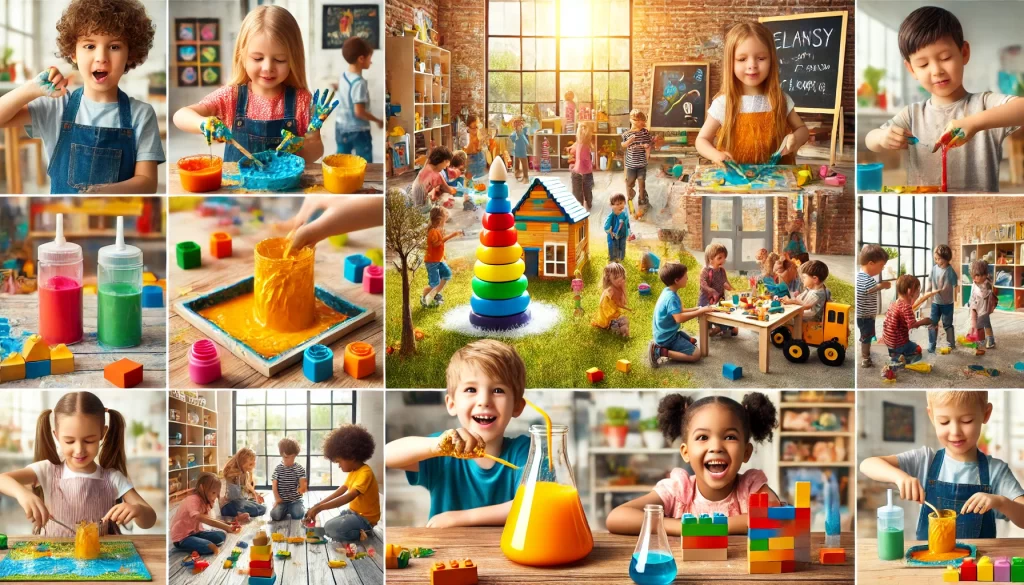How Hands-On Activities Spark Genius in Young Minds

Picture this: a kitchen covered in flour, a living room floor scattered with LEGO towers, or a backyard transformed into a muddy science lab.
Kids and mess go hand in hand—but what if those messy moments were actually helping them learn in the best way possible?
But what if I told you that those messy moments are actually helping kids learn in the best way possible?
Science proves it!
When kids get hands-on with learning—building, touching, experimenting—their brains light up way more than when they just sit and listen.
So, let’s roll up our sleeves, embrace the mess, and see how hands-on activities turn kids into little geniuses.
The Science Behind Hands-On Learning
Ever notice how you remember things better when you actually do them instead of just reading or listening?
That’s because when kids touch, move, and experiment, their brains make stronger connections. Studies show that kids who learn by doing remember more and understand better than those who just watch or listen.
And mistakes? They’re not failures—they’re learning in action! When kids mess up and have to figure out what went wrong, they get better at problem-solving and thinking critically.
That’s the real power of messy learning.
Why Messy Learning Is Awesome
1. Sparks Creativity and Curiosity
If you give a kid a worksheet, they’ll probably rush through it. But hand them a tray of paint, some feathers, and a cardboard box? Suddenly, they’re artists, inventors, and scientists all in one! Open-ended activities let kids explore and create, making learning way more exciting.
2. Builds Problem-Solving Skills
When a tower of blocks falls down, what does a kid do?
They try again!
Whether they’re building a bridge with popsicle sticks or mixing colors to get purple, they’re thinking, testing, and figuring things out.
That’s problem-solving in action!
3. Boosts Confidence and Independence
Messy learning gives kids a chance to figure things out on their own. They learn that mistakes are okay and that they can fix them.
Cooking, for example, is a great way to practice independence—let them crack the eggs, measure the flour, and mix the batter.
Sure, there might be a flour explosion, but they’ll gain new skills and feel super proud of themselves.
4. Strengthens Motor Skills
Messy play doesn’t just help brains—it helps bodies too! Developing motor skills through hands-on activities is essential for young learners.
Fine motor skills, like gripping a paintbrush or cutting with scissors, help with writing and self-care tasks.
Gross motor skills, like climbing or digging in the sand, improve balance, coordination, and overall physical health.
Activities like cutting, painting, and building improve fine motor skills, while outdoor play like mud kitchens, obstacle courses, and climbing help with coordination and strength.
Fun and Messy Learning Ideas
We’ve seen how messy learning helps kids think creatively, solve problems, and build important skills.
Now, let’s put that knowledge into action with some fun, hands-on activities that make learning exciting!
1. Mind-Blowing Science Experiments
- Baking Soda & Vinegar Volcanoes: Watch fizzing lava explode as kids learn about chemical reactions.
- DIY Slime and Oobleck: Is it a solid? Is it a liquid? It’s both! Kids love playing with these weird, stretchy, gooey mixtures.
- Growing Crystals or Sprouting Seeds: Watching things grow teaches patience and how nature works.
2. Messy Art That Goes Beyond Paper
- Finger Painting with Cool Materials: Try painting with cotton balls, sponges, or toy car wheels for a fun twist.
- Nature Art: Gather leaves, rocks, and sticks to create amazing textured art.
- Group Mural Projects: Let kids work together to create big, colorful art masterpieces.
3. Building and Engineering Fun
- LEGO and Block Challenges: See who can build the tallest tower or the strongest bridge.
- DIY Bridges with Everyday Items: Can kids make a bridge out of straws, tape, and paper that holds a small toy?
- Recycled Junk Creations: Turn old boxes, toilet paper rolls, and egg cartons into robots, castles, or cars.
4. Sensory Play for Brain Power
- Water and Sand Play: Splashing and digging helps kids learn about textures and cause-and-effect.
- Playdough, Kinetic Sand, and Cloud Dough: Squishing and shaping builds hand muscles and sparks creativity.
- Sound and Texture Exploration: Fill a bin with rice, beans, or beads and hide tiny toys inside for kids to find.
How to Handle the Mess Without Losing Your Mind
Okay, I get it—mess can be stressful. But don’t worry, here are some easy ways to keep things under control:
- Create a “Mess Zone” – Put down a plastic tablecloth or play outside where messes are easier to clean up.
- Use Washable Materials – Get washable paints, spill-proof containers, and aprons to make cleanup easier.
- Make Cleanup Part of the Fun – Give kids spray bottles and sponges and turn cleanup into a game.
- Enjoy the Process, Not Just the Result – The goal isn’t to make a perfect project—it’s to have fun and learn along the way!
Messy Learning = Big Discoveries
At the end of the day, messy learning isn’t about making a mess—it’s about creating opportunities for kids to experiment, take risks, and discover new things without fear of failure.
When children feel free to explore without worrying about making mistakes, they develop confidence, creativity, and a love for learning that lasts a lifetime.
The best learning happens when kids are excited, curious, and unafraid to get their hands dirty.
So next time your little scientist spills baking soda everywhere, or your future artist paints their hands more than the paper, take a deep breath and remember: this is where the magic happens.
Now, go have some messy fun! Your little genius is ready for it.

Leave a Reply
You must be logged in to post a comment.